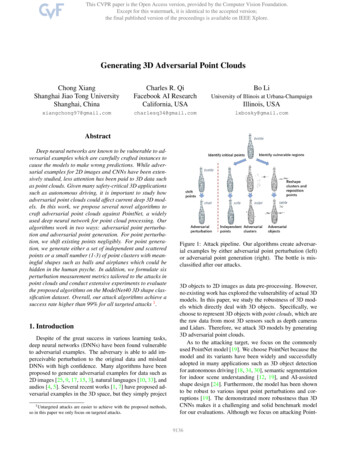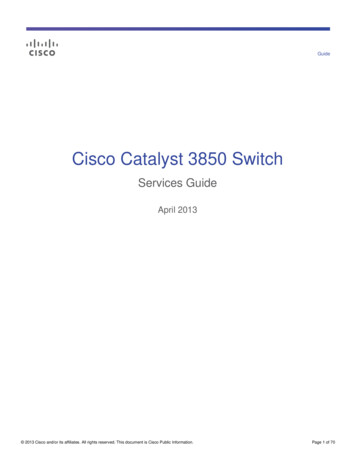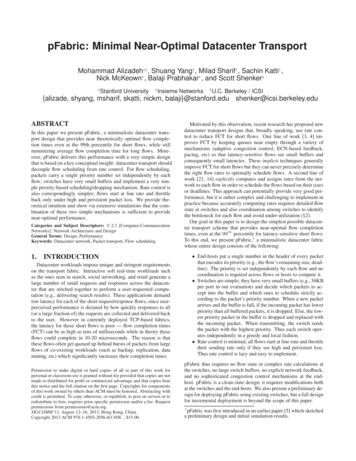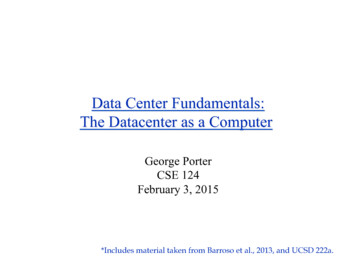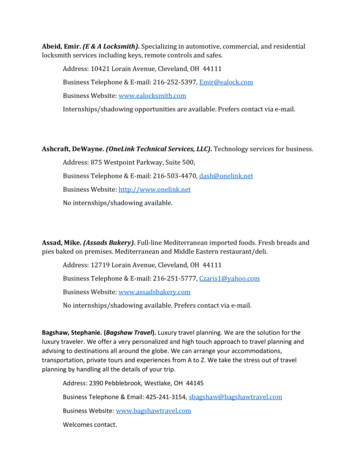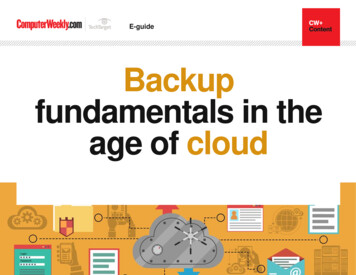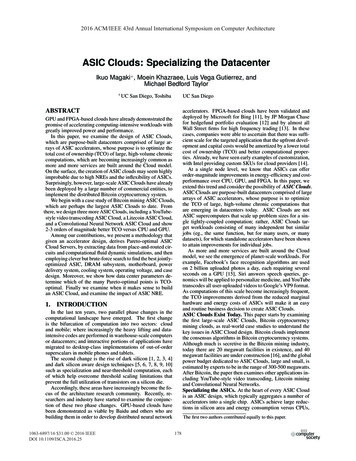
Transcription
2016 ACM/IEEE 43rd Annual International Symposium on Computer ArchitectureASIC Clouds: Specializing the DatacenterIkuo Magaki , Moein Khazraee, Luis Vega Gutierrez, andMichael Bedford Taylor UCSan Diego, ToshibaUC San DiegoABSTRACTGPU and FPGA-based clouds have already demonstrated thepromise of accelerating computing-intensive workloads withgreatly improved power and performance.In this paper, we examine the design of ASIC Clouds,which are purpose-built datacenters comprised of large arrays of ASIC accelerators, whose purpose is to optimize thetotal cost of ownership (TCO) of large, high-volume chroniccomputations, which are becoming increasingly common asmore and more services are built around the Cloud model.On the surface, the creation of ASIC clouds may seem highlyimprobable due to high NREs and the inflexibility of ASICs.Surprisingly, however, large-scale ASIC Clouds have alreadybeen deployed by a large number of commercial entities, toimplement the distributed Bitcoin cryptocurrency system.We begin with a case study of Bitcoin mining ASIC Clouds,which are perhaps the largest ASIC Clouds to date. Fromthere, we design three more ASIC Clouds, including a YouTubestyle video transcoding ASIC Cloud, a Litecoin ASIC Cloud,and a Convolutional Neural Network ASIC Cloud and show2-3 orders of magnitude better TCO versus CPU and GPU.Among our contributions, we present a methodology thatgiven an accelerator design, derives Pareto-optimal ASICCloud Servers, by extracting data from place-and-routed circuits and computational fluid dynamic simulations, and thenemploying clever but brute-force search to find the best jointlyoptimized ASIC, DRAM subsystem, motherboard, powerdelivery system, cooling system, operating voltage, and casedesign. Moreover, we show how data center parameters determine which of the many Pareto-optimal points is TCOoptimal. Finally we examine when it makes sense to buildan ASIC Cloud, and examine the impact of ASIC NRE.1.INTRODUCTIONIn the last ten years, two parallel phase changes in thecomputational landscape have emerged. The first changeis the bifurcation of computation into two sectors: cloudand mobile; where increasingly the heavy lifting and dataintensive codes are performed in warehouse-scale computersor datacenters; and interactive portions of applications havemigrated to desktop-class implementations of out-of-ordersuperscalars in mobile phones and tablets.The second change is the rise of dark silicon [1, 2, 3, 4]and dark silicon aware design techniques [5, 6, 7, 8, 9, 10]such as specialization and near-threshold computation, eachof which help overcome threshold scaling limitations thatprevent the full utilization of transistors on a silicon die.Accordingly, these areas have increasingly become the focus of the architecture research community. Recently, researchers and industry have started to examine the conjunction of these two phase changes. GPU-based clouds havebeen demonstrated as viable by Baidu and others who arebuilding them in order to develop distributed neural network1063-6897/16 31.00 2016 IEEEDOI 10.1109/ISCA.2016.25accelerators. FPGA-based clouds have been validated anddeployed by Microsoft for Bing [11], by JP Morgan Chasefor hedgefund portfolio evaluation [12] and by almost allWall Street firms for high frequency trading [13]. In thesecases, companies were able to ascertain that there was sufficient scale for the targeted application that the upfront development and capital costs would be amortized by a lower totalcost of ownership (TCO) and better computational properties. Already, we have seen early examples of customization,with Intel providing custom SKUs for cloud providers [14].At a single node level, we know that ASICs can offerorder-magnitude improvements in energy-efficiency and costperformance over CPU, GPU, and FPGA. In this paper, weextend this trend and consider the possibility of ASIC Clouds.ASIC Clouds are purpose-built datacenters comprised of largearrays of ASIC accelerators, whose purpose is to optimizethe TCO of large, high-volume chronic computations thatare emerging in datacenters today. ASIC Clouds are notASIC supercomputers that scale up problem sizes for a single tightly-coupled computation; rather, ASIC Clouds target workloads consisting of many independent but similarjobs (eg., the same function, but for many users, or manydatasets), for which standalone accelerators have been shownto attain improvements for individual jobs.As more and more services are built around the Cloudmodel, we see the emergence of planet-scale workloads. Forexample, Facebook’s face recognition algorithms are usedon 2 billion uploaded photos a day, each requiring severalseconds on a GPU [15], Siri answers speech queries, genomics will be applied to personalize medicine, and YouTubetranscodes all user-uploaded videos to Google’s VP9 format.As computations of this scale become increasingly frequent,the TCO improvements derived from the reduced marginalhardware and energy costs of ASICs will make it an easyand routine business decision to create ASIC Clouds.ASIC Clouds Exist Today. This paper starts by examiningthe first large-scale ASIC Clouds, Bitcoin cryptocurrencymining clouds, as real-world case studies to understand thekey issues in ASIC Cloud design. Bitcoin clouds implementthe consensus algorithms in Bitcoin cryptocurrency systems.Although much is secretive in the Bitcoin mining industry,today there are 20 megawatt facilities in existence, and 40megawatt facilities are under construction [16], and the globalpower budget dedicated to ASIC Clouds, large and small, isestimated by experts to be in the range of 300-500 megawatts.After Bitcoin, the paper then examines other applications including YouTube-style video transcoding, Litecoin miningand Convolutional Neural Networks.Specializing the ASICs. At the heart of every ASIC Cloudis an ASIC design, which typically aggregates a number ofaccelerators into a single chip. ASICs achieve large reductions in silicon area and energy consumption versus CPUs,The first two authors contributed equally to this paper.178
GPUs, and FPGAs because they are able to exactly provision the required resources needed for the computation.They can replace area-intensive, energy-wasteful instructioninterpreters with area-efficient, energy-efficient parallel circuits. ASIC designers can dial in exactly the optimal voltageand thermal profile for the computation. They can customizethe I/O resources, instantiating precisely the right number ofDRAM, PCI-e, HyperTransport and Gig-E controllers, andemploy optimized packages with optimal pin allocation.Bitcoin ASIC specialization efforts have been prolific: over27 unique Bitcoin mining ASICs have been successfully implemented in the last three years [17]. The first three ASICswere developed in 130 nm, 110 nm, and 65 nm, respectively;55 nm and 28 nm versions followed quickly afterwards. Today, you can find chips manufactured in the state-of-the artFinFET technologies: Intel 22 nm and TSMC 16 nm. Although many original designs employed standard-cell design, competitive designs are full-custom, have custom packages, and as of 2016, operate at near-threshold voltages.Specializing the ASIC Server. In addition to exploitingspecialization at the ASIC design level, ASIC Clouds canspecialize the server itself. A typical datacenter server is encrusted with a plethora of x86/PC support chips, multi-phasevoltage regulators supporting DVFS, connectors, DRAMs,and I/O devices, many of which can be stripped away for aparticular application. Moreover, typical Xeon servers embody a CPU-centric design, where computation (and profit!)is concentrated in a very small area of the PCB, creating extreme hotspots. This results in heavy-weight local coolingsolutions that obstruct delivery of cool air across the system, resulting in sub-optimal system-level thermal properties. ASIC Servers in Bitcoin ASIC Clouds integrate arrays of ASICs organized evenly across parallel shotgun-styleairducts that use wide arrays of low-cost heatsinks to efficiently transfer heat out of the system and provide uniform thermal profiles. ASIC Cloud servers use a customizedprinted circuit board, specialized cooling systems and specialized power delivery systems, and can customize the DRAMtype (e.g., LP-DDR3, DDR4, GDDR5, HBM.) and DRAMcount for the application at hand, as well as the minimal necessary I/O devices and connectors required. Further, theyemploy custom voltages in order to tune TCO.Specializing the ASIC Datacenter. ASIC Clouds can alsoexploit specialization at the datacenter level, optimizing racklevel and datacenter-level thermals and power delivery thatexploit the uniformity of the system. More importantly, cloudlevel parameters (e.g., energy provisioning cost and availability, depreciation and . taxes) are pushed down into theserver and ASIC design to influence cost- and energy- efficiency of computation, producing the TCO-optimal design.Analyzing Four Kinds of ASIC Clouds. In this paper webegin by analyzing Bitcoin mining ASIC Clouds in depth,and distill both their unique characteristics and characteristics that are likely to apply across other ASIC Clouds. Wedevelop the tools for designing and analyzing Pareto- andTCO- optimal ASIC Clouds. By considering ASIC Cloudchip design, server design, and finally data center design ina bottom-up way, we reveal how the designers of these novelsystems can optimize the TCO in real-world ASIC Clouds.From there, we examine other ASIC Clouds designs, extending the tools for three exciting emerging cloud workloads: YouTube-style Video Transcoding, Litecoin miningand Convolutional Neural Networks.When To Go ASIC Cloud. Finally, we examine when it179makes sense to design and deploy an ASIC Cloud, considering NRE. Since inherently ASICs and ASIC Clouds gaintheir benefits from specialization, each ASIC Cloud will bespecialized using its own combination of techniques. Ourexperience suggests that, as with much of computer architecture, many techniques are reused and re-combined in different ways to create the best solution for each ASIC Cloud.2. BITCOIN: AN EARLY ASIC CLOUDIn this section, we overview the underlying concepts in theBitcoin cryptocurrency system embodied by Bitcoin ASICClouds. An overview of the Bitcoin cryptocurrency systemand an early history of Bitcoin mining can be found in [18].Cryptocurrency systems like Bitcoin provide a mechanismby which parties can semi-anonymously and securely transfer money between each other over the Internet. Unlikeclosed systems like Paypal or the VISA credit card system,these systems are open source and run in a distributed fashion across a network of untrusted machines situated all overthe world. The primary mechanism that these machines implement is a global, public ledger of transactions, called theblockchain. This blockchain is replicated many times acrossthe world. Periodically, every ten minutes or so, a block ofnew transactions is aggregated and posted to the ledger. Alltransactions since the beginning can be inspected1 .Mining. A distributed consensus technique called Byzantine Fault Tolerance determines whose transactions are addedto the blockchain, in the following way. Machines on thenetwork request work to do from a third-party pool server.This work consists of performing an operation called mining, which is a computationally intense operation which involves brute force partial inversion of a cryptographicallyhard hash function like SHA256 or scrypt. The only knownway to perform these operations is to repeatedly try a newinputs, and run the input through the cryptographic functionand see if the output has the requisite number of starting zeros. Each such attempt is a called a hash, and the numberof hashes that a machine or group of machines performs iscalled its hashrate, which is typically quote in terms of billions of hashes per second, or gigahash per second (GH/s).When a machine succeeds, it will broadcast that it has addeda block to the ledger, and the input value is the proof of workthat it has played by the rules. The other machines on thenetwork will examine the new block, determine if the transaction is legitimate (i.e. did somebody try to create currency,or transfer more money than was available from a particularaccount, or is the proof-of-work invalid), and if it is, theywill use this new updated chain and attempt to post theirtransactions to the end of the new chain. In the infrequentcase where two machines on the network have found a winning hash and broadcasted new blocks in parallel, and thechain has "forked", the long version has priority.The first two ASIC Clouds analyzed in this paper targetmining for the two most dominant distributed cryptocurrencies: Bitcoin and Litecoin. People are incentivized to perform mining for three reasons. First, there is an ideological reason: the more machines that mine, the more securethe cryptocurrency network is from attacks. Second, every time a machine succeeds in posting a transaction to theblockchain, it receives a blockchain reward by including apayment transaction to its own account. In the case of Bitcoin, this reward is substantial: 25 bitcoins (or BTC), valued1 Seehttp://blockchain.info to see real-time ledger updates.
Figure 1 shows the corresponding rise in total global network hashrate over time, normalized to the difficulty runningon a few CPUs. The difficulty and hashrate have increasedby an incredible factor of 50 billion since 2009, reaching approximately 575 million GH/s as of November 2015.By scavenging data from company press releases, blogs,bitcointalk.org, and by interviewing chip designers at thesecompanies, we have reconstructed the progression of technology in the Bitcoin mining industry, which we annotateon Figure 1, and describe in this section.Gen 1-3. The first generation of Bitcoin miners were CPU’s,the second generation were GPU’s and the third generationwere FPGAs. See [18] for more details.Gen 4. The fourth generation of Bitcoin miners started withthe first ASIC (ASICMiner, standard cell, 130-nm) that wasreceived from fab in late December 2012. Two other ASICs(Avalon, standard cell, 110-nm and Butterfly Labs, full custom, 65-nm) were concurrently developed by other teamswith the first ASIC and released shortly afterwards. Thesefirst ASICs, built on older, cheaper technology nodes withlow NREs, served to confirm the existence of a market forspecialized Bitcoin mining hardware.These first three ASICs had different mechanisms of deployment. ASICMiner sold shares in their firm on an onlinebitcoin-denominated stock exchange, and then built their ownmining datacenter in China. Thus, the first ASICs developedfor Bitcoin were used to create an ASIC Cloud system. Thebitcoins mined were paid out to the investors as dividends.Because ASICMiner did not have to ship units to customers,they were the first to be able to mine and thus captured alarge fraction of the total network hash rate. Avalon and Butterfly Labs used a Kickstarter-style pre-order sales model,where revenue from the sales funded the NRE of the ASICdevelopment. As the machines become available, they wereshipped sequentially by customer order date.Gen 5. The fifth generation of Bitcoin miners started when,upon seeing the success of the first group of ASICs, a second group of firms with greater capitalization developed andreleased the second wave of ASICs which used better process technology. Bitfury was the first to reach 55-nm in mid2013 with a best-of-class full custom implementation, thenHashfast reached 28-nm in Oct. 2013, and there is evidencethat 21, Inc hit the Intel 22-nm node around Dec 2013.Gen 6. The current generation, the fifth generation of miningASICs, is by companies that survived the second wave, andtargets bleeding edge nodes as they came out (e.g. TSMC20-nm and TSMC 16-nm). So far, these advanced nodeshave only been utilized by ASIC manufacturers whose intentis to populate and run their own ASIC Clouds.Moving to Cloud Model. Most companies that build Bitcoin mining ASICs, such as Swedish firm KnCminer, havemoved away from selling hardware to end users, and insteadnow maintain their own private clouds [19], which are located in areas that have low-cost energy and cooling. Forexample KnCminer has a facility in Iceland, because there isgeothermal and hydroelectric energy available at extremelylow cost, and because cool air is readily available. Bitfurycreated a 20 MW mining facility in the Republic of Georgia,where electricity is also cheap. Their datacenter was constructed in less than a month, and they have raised funds fora 100 MW data center in the future.Optimizing TCO. Merged datacenter operation and ASICdevelopment have become the industry norm for several reasons. First, the datacenter, enclosing server and the �11’12’13’14’15’16Figure 1: Rising Global Bitcoin ASIC Computation and Corresponding Increase in Bitcoin ASIC Cloud Specialization. Numbers are ASIC nodes, in nm. Difficulty is the ratio of the currentworld Bitcoin hash throughput relative to the initial mining network throughput, 7.15 MH/s. In the six-year period preceding Nov2015, throughput has increased by 50 billion times, correspondingto a world hash rate of approximately 575 million GH/s. The firstrelease date of a miner on each ASIC node is annotated.at 10,725 on the BTC-USD exchanges in April 2016. Sinceapproximately 144 blocks are mined per day, the total valueper day of mining is around 1.5M USD. Mining is the onlyway that currency is created in the Bitcoin system. Third,the machine also receives optional tips attached to the transaction; these tips comprise only a few percent of revenue.In order to control the rate at which new Bitcoin are created, approximately every 2016 blocks (or two weeks), thedifficulty of mining is adjusted by increasing the number ofleading zeros required, according to how fast the last groupof 2016 blocks was solved. Thus, with slight hysteresis, thefraction of the 3600 bitcoins distributed daily that a minerreceives is approximately proportional to the ratio of theirhashrate to the world-wide network hashrate.Economic Value of Bitcoins. Bitcoins have become increasingly valuable over time as demand increases. The valuestarted at around 0.07, and increased by over 15,000 toover 1,000 in late 2013. Since then, the price has stabilized, and as of late April 2016, is around 429, and over 6.5 billion USD worth of BTC are in circulation today. Famously, early in the Bitcoin days, a pizza was purchased for10,000 BTC, worth 4.3 million USD today. The value ofa BTC multiplied by yearly number of BTC mined determines in turn the yearly revenue of the entire Bitcoin miningindustry, which is currently at 563M USD per year.3.RAMPING THE TECHNOLOGY CURVETO ASIC CLOUDAs BTC value exponentially increased, the global amountof mining has increased greatly, and the effort and capitalexpended in optimizing machines to reduce TCO has alsoincreased. This effort in turn increases the capabilities andquantity of machines that are mining today. Bitcoin ASICClouds have rapidly evolved through the full spectrum ofspecialization, from CPU to GPU, from GPU to FPGA, fromFPGA to older ASIC nodes, and finally to the latest ASICnodes. ASIC Clouds in general will follow this same evolution: rising TCO of a particular computation justifies increasingly higher expenditure of NRE’s and developmentcosts, leading to greater specialization.180
/CLKOscillatorFPGA or uCGridPlane1 U1 UPSUOn-PCB NetworkRCA1 U1U1UMachine room42U-RackASICFansOn-ASIC NetworkServerASICFigure 2: High-Level Abstract Architecture of an ASIC Cloud.can be co-designed with fewer unknowns, eliminating theneed to accommodate varying customer environments (energy cost, temperature, customs and certifications, 220V/110V,setup guides, tech support.) and enabling new kinds of optimizations that trade off cost, energy efficiency and performance. Second, ASIC Cloud bringup time is greatly shortened if the product does not have to be packaged, troubleshootedand shipped to the customer, which means that the chips canbe put into use earlier. Finally, meeting an exact target foran ASIC chip is a challenging process, and tuning the systemuntil it meets the promised specifications exactly (energy efficiency, performance) before shipping to the customer delays the deployment of the ASICs and the time at which theycan start reducing TCO of the computation at hand.CPU-based machines has been replaced with a new kind ofnascent ASIC Cloud, it may occupy only a tiny part of a datacenter2 , and thus have little flexibility in dictating the machine room’s parameters. Accordingly, we employ a modified version of the standard warehouse scale computer modelfrom Barroso et al [21]. We assume that the machine roomis capable of providing inlet air to the racks at 30 C.ASIC Cloud Servers. Each rack contains an array of servers.Each server contains a high-efficiency power supply (PSU),an array of inlet fans, and a customized printed circuit board(PCB) that contains an array of specialized ASICs, and acontrol processor (typically an FPGA or microcontroller, butalso potentially a CPU) that schedules computation acrossthe ASICs via a customized on-PCB multidrop or point-topoint interconnection network. The control processor alsoroutes data from the off-PCB interfaces to the on-PCB network to feed the ASICs. Depending on the required bandwidth, the on-PCB network could be as simple as a 4-pinSPI interface, or it could be high-bandwidth HyperTransport, RapidIO or QPI links. Candidate off-PCB interfacesinclude PCI-e (like in Convey HC1 and HC2), commodity1/10/40 GigE interfaces, and high speed point-to-point 1020 gbps serial links like Microsoft Catapult’s inter-systemSL3 links. All these interfaces enable communication between neighboring 1U modules in a 42U rack, and in manycases, across a rack and even between neighboring racks.Since the PSU outputs 12V DC, our baseline ASIC servercontains a number of DC/DC converters which serve to stepcurrent down to the 0.4-1.5 V ASIC core voltage. Finally,flip-chip designs have heat sinks on each chip, and wirebonded QFNs have heat sinks on the PCB backside.ASICs. Each customized ASIC contains an array of RCA’sconnected by an on-ASIC interconnection network, a routerfor the on-PCB (but off-ASIC) network, a control plane thatinterprets incoming packets from the on-PCB network andschedules computation and data onto the RCA’s, thermalsensors, and one or more PLL or CLK generation circuits.In Figure 2, we show the Power Grid explicitly, because forhigh power density or low-voltage ASICs, it will have tobe engineered explicitly for low IR drop and high current.Depending on the application, for example, our Convolutional Neural Network ASIC Cloud, the ASIC may use the4. PARETO- AND TCO- OPTIMALITYIn ASIC Clouds, two key metrics define the design space:hardware cost per performance ( per op/s, which for Bitcoin is per GH/s), and energy per operation (Watts perop/s, equivalent to Joules per op, which for Bitcoin is W perGH/s). Designs can be evaluated according to these metrics,and mapped into a Pareto space that trades cost and energyefficiency. Joint knowledge and control over datacenterand hardware design allows for the ASIC designers to select the single TCO-optimal point by correctly weightingthe importance of cost per performance and energy perop among the set of Pareto-optimal points.5. ARCHITECTURE OF AN ASIC CLOUDWe starting by examining the design decisions that applygenerally across ASIC Clouds. Later, we design four example ASIC Cloud for Bitcoin, Litecoin, Video Transcoding,and Convolutional Neural Networks.At the heart of any ASIC Cloud is an energy-efficient,high-performance, specialized replicated compute accelerator, or RCA, that is multiplied up by having multiple copiesper ASICs, multiple ASICs per server, multiple servers perrack, and multiple racks per datacenter. Work requests fromoutside the datacenter will be distributed across these RCAsin a scale-out fashion. All system components can be customized for the application to minimize TCO.Figure 2 shows the architecture of a basic ASIC Cloud.Starting from the left, we start with the data center’s machine room, which contains a number of 42U-style racks. Inthis paper, we try to minimize our requirements for the machine room because in many cases, after an array of GPU or2 In the case of Bitcoin, the scale of computation has been increasedso greatly that the machine rooms are filled with only Bitcoin hardware and as a result are heavily customized for Bitcoin to reduceTCO, including the use of immersion cooling [20].181
PSU(90% efficiency)mesh " Host Processor " ASICAll dies are the samearea.!,! 0 , 0 DC/DCsSupply up to 30W/each90% efficiency' % # ) High static-pressure fan(12V, 7.5W) " ( ' %" ! # " Figure 3: The ASIC Cloud server model. ! * # * # on-ASIC network for high-bandwidth interfaces between thereplicated compute accelerators, and the on-PCB networkbetween chips at the 1U server level. If the RCA requiresDRAM, then the ASIC contains a number of shared DRAMcontrollers connected to ASIC-local DRAMs. The on-PCBnetwork is used by the PCB control processor to route datafrom the off-PCB interfaces to the ASICs to the DRAMs.This paper examines a spectrum of ASIC Clouds with diverse needs. Bitcoin ASIC Clouds required no inter-chip orinter-RCA bandwidth, but have ultra-high power density, because they have little on-chip SRAM. Litecoin ASIC Cloudsare SRAM-intensive, and have lower power density. VideoTranscoding ASIC Clouds require DRAMs next to each ASIC,and high off-PCB bandwidth. Finally, our DaDianNao-style [22]Convolutional Neural Network ASIC Clouds make use ofon-ASIC eDRAM and HyperTransport links between ASICsto scale to large multichip CNN accelerators.Voltage. In addition to specialization, voltage optimizationis a key factor that determines ASIC Cloud energy efficiencyand performance. We will show how the TCO-optimal voltage can be selected across ASIC Clouds. ' % # Figure 4: ASIC Server Evaluation Flow. The server cost, perserver hash rate, and energy efficiency are evaluated using RCAproperties, and a flow that optimizes server heat sinks, die size,voltage and power density.moval, taking cold air at 30 C from the front using a number of 1U-high fans, and exhausting the hot air from the rear.The power supply unit (PSU) is located on the leftmost sideof the server, and a thin wall separates the PSU from thePCB housing. Because of this separation and its capabilityof cooling itself, the PSU is ignored in terms of thermal analysis in the remaining part of this section. Figure 3 providesthe basic parameters of our thermal model.6.2ASIC Server ModelIn order to explore the design space of ASIC Cloud Servers,we have built a comprehensive evaluation flow, shown inFigure 4, that takes in application parameters and a set ofspecifications and optimizes a system with those specs. Werepeatedly run the evaluation flow across the design space inorder to determine Pareto optimal points that trade off perop/s and W per op/s.Given an implementation and architecture for the targetRCA, VLSI tools are used to map it to the target process(in our case, fully placed and routed designs in UMC 28-nmusing Synopsys IC compiler), and analysis tools (e.g. PrimeTime) provide information on frequency, performance, areaand power usage, which comprise the RCA Spec. This information and a core voltage is then applied to a voltage scalingmodel that provides a spectrum of Pareto points connectingW per mm2 and op/s per mm2 . From there, we compute theoptimal ASIC die size, ASIC count, and heat sink configuration for the server, while ensuring that the transistors oneach die stay within maximum junction temperature limits.Then, the tool outputs the optimized configuration and alsothe performance, energy, cost, and power metrics. Table 1shows the input parameters.6. DESIGN OF AN ASIC SERVERIn this section, we examine the general principals in ASICCloud Server design to find the Pareto frontier across perop/s and W per op/s. Using area, performance and powerdensity metrics of an RCA we show how to optimize theASIC Server by tuning the number of RCAs placed on eachchip; the number of chips placed on the PCB; their organization on the PCB; the way the power is delivered to theASICs; how the server is cooled; and finally the choice ofvoltage. Subsequent sections apply these principles to ourfour prototypical ASIC Clouds.6.1!,! 0 ,! & .,! & ), ! * " % ) / ! ASIC Server OverviewDelayFigure 3 shows the overview of our baseline ASIC Cloudserver. In our study, we focus on 1U 19-inch rackmountservers. The choice of a standardized server form factormaximizes the compatibility of the design with existing machine room infrastructures, and also allows the design tominimize energy and components cost by making use ofstandardized high-volume commodity server components. Thesame analysis in our paper could be applied to 2U systemsas well. Notably, almost all latest-generation Bitcoin mining ASIC Cloud servers have higher maximum power density than can be sustained in a fully populated rack; so racksare generally not fully populated. Having this high densitymakes it easier to allocate the number of servers to a rackaccording to the data center’s per-rack power and coolingtargets without worrying about space constraints.The servers employ forced-air cooling system for heat re-141210864200.40.50.6 0.7 0.8Logic VDD (V)0.91Figure 5: The Delay-Voltage curve for 28-nm logic.182
ASIC Clouds: Specializing the Datacenter Ikuo Magaki , Moein Khazraee, Luis Vega Gutierrez, and Michael Bedford Taylor
